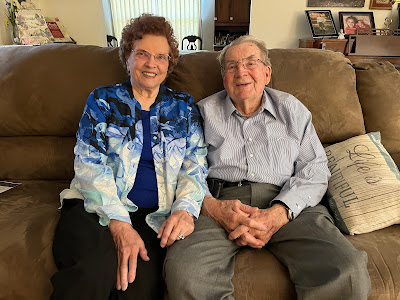School kindergarteners usually celebrate 100 DAYS of school. To a kindergartener, 100 days seems like a really long time, especially when they have to help Mama glue 100 pompoms to a t-shirt (or some other commemorative effort).
Celebrating 100 YEARS doesn't often happen in this disposable, fast food society. However, Randy and I were happy to be a part of celebrating 100 years of FarmHouse fraternity last weekend in Manhattan. Just like with many big events, the centennial was delayed from 2021, due to Covid. But it didn't seem to affect the crowd: More than 400 members, spouses, FarmHouse staff and guests attended the Kansas State FarmHouse Centennial Celebration, April 22-23, 2022. The guys gathered for a panorama shot after the banquet.
 |
| Photo by Photographer Cody Cramer |
Our keynote speaker for the evening banquet was a FarmHouse alum, Randy Linville. He owns his own consulting firm now and is a former CEO of the Scoular Grain Co.
 |
| Randy Linville photo by Cody Cramer |
In his remarks, he talked about how unusual it is to reach the 100-year mark as an organization. For example, some of the hottest major brands today are also relatively young: Apple debuted in 1976, Amazon was launched in 1995, and Google didn’t fully hatch until 1998. Who knows whether they will be around to celebrate 100? My crystal ball is as cloudy as usual today.
Actually, the percentage of U.S. companies that make it to the 100-year mark is such a small number, there is no clear go-to source for accurate data on the topic. The U.S. Bureau of Labor Statistics data shows that only 36 percent of companies last 10 years and about 21 percent survive to see their 20th anniversary. Beyond that, the U.S. Census Bureau reports that only about 12 percent of companies are older than 26 years.
My research found this: The prevailing theory, though unconfirmed, is that only about a half a percent (0.5%) of all companies have what it takes to last 100 years. This means that centennial organizations truly do have lots to celebrate. They’re so rare it’s difficult to calculate just how rare they are.
I've spent some time thinking about the 100-year mark since then, and I realize that we are personally connected to several organizations which have already celebrated their centennials. These particular ones also have their roots in agriculture or rural areas:
- Kansas 4-H program, 1906 (National 4-H program, 1902)
- Kanza Cooperative, (Iuka Co-op established 1915, a predecessor to Kanza. The Iuka Co-op is where I trucked wheat as a high school driver on my family's Pratt County farm.)
- Kansas Farm Bureau, established 1919
- Kansas Master Farmers and Master Farm Homemakers, established 1927
 Grandpa Neelly on his 100th birthday in 2004 with the great-grandkids:
Grandpa Neelly on his 100th birthday in 2004 with the great-grandkids:Front row: Abby, Paige, Grandpa, Jill and Madison.
Back row: Blake, Brian and Brent.
Yes, this photo of the FarmHouse Little Sisters is old enough to be yellowed. (A few years ago, my friend and fellow Little Sister, Shari, sent this photo to me via Facebook Messenger, and we attempted to identify all those pictured. We didn't do too badly in our efforts.)
Several of us gathered Saturday night for a photo after the banquet.
My sister, Lisa, was in a different room, but a couple of Little Sisters found her afterwards.
.jpg) | |
| Cindy, Shari & Lisa |
Both Lisa and I married FarmHouse guys. My brother, Kent, and his son, Brian, were FH men. Lisa's husband, Kyle, was a FH guy, as was their son, Blake. Blake served as finance manager for a rebuilding/renovation project at the Kansas State University chapter house, which was also celebrated on Saturday. Our son-in-law, Eric - as well as his dad, uncle and Eric's two brothers - are FH alums.
Even though Grandpa's been gone for years, it still seemed a little like he was part of the special day. Lisa snapped a photo of the Study Room at the chapter house, which was named in Grandpa's honor.
Grandpa would have loved the centennial event.
Randy and his friend, Rex, who is a high school classmate as well as a FH brother, certainly did! We all got to visit with friends we hadn't seen in years.Randy's name was on a plaque for the scholarship room. We took a photo - just in case people wouldn't believe it. He says it wouldn't have been a surprise for my name to be on a scholarship plaque. However, he says his inclusion on a plaque for grades is worth commemorating.
One of my favorite parts of the night was the guys singing together near the end. Since Randy and I weren't dating in college, I didn't ever get to hear "A FarmHouse Girl" sung to me for a pinning or an engagement.
 |
| Photos by Gina Dreher Photography, Wichita |
But one of my (many) favorite moments from Jill's and Eric's wedding was when the FH guys at the reception surrounded Jill with a serenade. It never gets old to hear that harmony at the end. It gives me goosebumps every time!












































.JPG)




